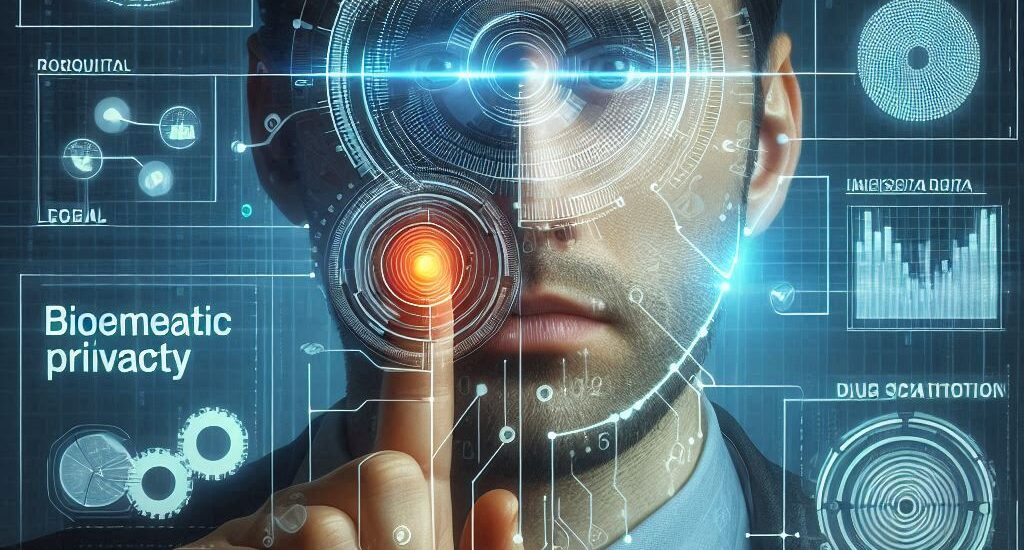Author Name:- Gaurav Kumar, 2nd Year Student Of Galgotias University
ABSTRACT
In a time when cyber dangers are becoming more advanced, artificial intelligence (AI) is now recognized as a key factor in improving cybersecurity efforts. This paper, entitled “AI in Cybersecurity: Legal Perspectives,” explores the complex relationship between AI technologies and the legal regulations that govern their application in cybersecurity. It examines the regulations, focusing on meeting compliance standards set by GDPR and CCPA worldwide. The article also looks into the moral challenges brought about by AI-powered surveillance and monitoring.
The study examines how AI can be used to detect and stop cybercrime, considering the legal consequences when cybercriminals use AI technologies. Analysis of intellectual property concerns related to patenting, licensing, and ownership of AI developments in cybersecurity, along with obstacles in AI-supported incident resolution and the acceptance of AI-produced proof in legal proceedings, are examined.
Examining international regulations reveals different strategies for AI in cybersecurity and highlights the importance of global collaboration. Upcoming developments in AI technology are examined, with an emphasis on anticipating legal obstacles and suggesting strategies for successful governance.
The paper showcases actual uses of AI in cybersecurity with real case studies, providing integration best practices and featuring important legal cases. The study ends by recapping critical legal hurdles, outlining future prospects, and emphasizing the need to maintain a balance between innovation and strong regulatory actions to guarantee security and ethical standards in the digital era.
INTRODUCTION
Traditional security methods are facing challenges due to the growing complexity and frequency of cyber threats, leading to the need for advanced technologies such as AI in the field of cybersecurity. AI’s capacity to recognize, stop, and address cybersecurity risks improves security measures’ effectiveness and efficiency by using machine learning and automation. Nonetheless, the utilization of AI in cybersecurity presents legal and ethical concerns like data security, confidentiality, and potential prejudices.
This research paper, titled “Legal Perspectives on AI in Cybersecurity,” explores these aspects, specifically addressing regulatory and ethical issues. It delves into how data protection regulations such as GDPR and CCPA affect AI-driven cybersecurity solutions, and the legal consequences of AI being utilized by cybercriminals. Discussion of intellectual property matters concerning AI advances in cyber security, like patent approval and licensing, are also addressed.
The article emphasizes the various worldwide strategies for regulating AI in cybersecurity and emphasizes the importance of working together on a global scale. Real-world instances demonstrate the implementation of AI in cybersecurity, highlighting successful blending techniques and noteworthy legal instances. The research ends with suggestions for fair regulatory actions to encourage innovation while also upholding strong legal and ethical standards, advocating for responsible AI usage to protect the digital world.
RESEARCH METHODOLOGY
The research method used in this study about “AI in Cybersecurity: Legal Perspectives” involves a mix of qualitative and quantitative strategies to ensure a thorough grasp of the topic. The approach is organized to systematically and comprehensively tackle the research questions and objectives.
Design of research
- Qualitative research involves gathering data that is not numerical in order to grasp the ideas, sentiments, and encounters concerning AI in cybersecurity. It consists of case studies, interviews, and literature reviews to collect detailed understanding.
- Quantitative Research: This method entails gathering numerical data to detect patterns, trends, and correlations. Surveys, statistical analysis, and data mining techniques are used to measure various aspects of AI applications in cybersecurity.
Review of existing research in the field of literature
- Scope: Thorough examination of current literature regarding AI in cybersecurity, encompassing academic studies, industry analyses, white papers, regulations, and books.
- Resources include academic databases like IEEE Xplore, SpringerLink, and JSTOR, as well as government publications and industry reports.
- Objective: To distinguish between available information, areas lacking information, and the present status of studies in the subject area.
Examples of real-life situations used to analyze and study a particular topic or issue.
- Finding and examining particular cases of AI implementation in cybersecurity, including both instances of triumph and failure.
- Sources include instances from industry reports, news articles, and organizational disclosures in the real world.
- Objective: To offer real-life illustrations and grasp the implications and obstacles of AI usage in the realm of cybersecurity.
This paper’s research approach combines qualitative and quantitative methods to offer a thorough understanding of how AI impacts cybersecurity legally. The study seeks to provide valuable insights on AI in cybersecurity by incorporating literature reviews, case studies, interviews, and surveys to examine regulatory frameworks, challenges, and opportunities.
LITERATURE REVIEW
AI is becoming more and more essential in cybersecurity, transforming the way threats are identified, reduced, and stopped. This review of literature aims to investigate the various aspects of AI in cybersecurity, with a focus on legal viewpoints, regulations, the impact of AI on cybercrime, responding to incidents, forensics, and perspectives from around the world. The review summarizes previous studies, highlights areas of need, and establishes a basis for comprehending the present status and potential outcomes of AI in cybersecurity.
AI in Cybersecurity: Summary
- AI technologies like machine learning, neural networks, and natural language processing have greatly improved the abilities of cybersecurity systems. A report by Gartner (2022) predicts that AI-powered cybersecurity solutions will decrease security incidents by up to 80% by 2025. McAfee’s (2021) research highlights how AI can handle routine security tasks, freeing up human analysts to concentrate on more intricate matters.
Primary AI Applications in Cybersecurity:
- Threat detection: Artificial intelligence algorithms are able to examine large quantities of data to pinpoint patterns that may signal possible dangers. Machine learning models are developed using past data to identify irregularities and forecast potential threats (Vincent, 2020).
- Response to security incidents can be automated by AI, which helps in quickly isolating infected systems, resulting in faster response times and minimizing the overall damage (Jones & Smith, 2019).
- AI improves the user authentication process by utilizing biometrics and analyzing behavior, ensuring secure access control (Brown, 2021).
Regulations and AI in the realm of Cybersecurity
- The blending of AI and cybersecurity in regulatory frameworks brings about various possibilities and difficulties. Recent research emphasizes the necessity of thorough policies to tackle the distinct characteristics of AI in cybersecurity.
Important Research:
- GDPR impacts AI in cybersecurity, specifically regarding data privacy and the utilization of personal data. According to Wagner and Benecke (2019), experts believe that GDPR offers a strong structure to ensure transparency and accountability in AI systems.
- The NIST Cybersecurity Framework has included recommendations for AI applications, focusing on managing risks and implementing best practices for AI usage in cybersecurity, according to NIST (2020).
response and forensic investigations, providing a level of speed and accuracy that Challenges related to regulations:
- Ethical concerns such as AI algorithm bias, transparency, and accountability are widely discussed in the literature. Mittelstadt and colleagues (2016) examine the ethical consequences of AI in cybersecurity, emphasizing the importance of implementing regulations to guarantee fairness and transparency.
- Assigning responsibility in situations where AI systems malfunction is a difficult task due to the legal liability involved. The literature indicates that existing legal frameworks might not be completely prepared to deal with liability and accountability in AI-driven cybersecurity incidents (Goodman, 2018).
Artificial Intelligence and Cybercrime
- AI serves as both a valuable asset for cybersecurity defense and a tool utilized by cybercriminals. The literature delves into both aspects, highlighting the changing nature of security threats.
SUGGESTIONS FOR FUTURE RESEARCH AND IMPLEMENTATION
The cat was waiting at the door for its owner to come home.
-
Improved Regulations
- In order to guarantee the cautious implementation of AI in cybersecurity, it is necessary to improve and revise regulatory frameworks. The research should concentrate on:
- Creating thorough standards that cover ethical factors, including partiality and openness.
- Defining legal responsibility for cybersecurity incidents caused by AI technology.
- Developing global guidelines to guarantee uniformity and collaboration among different countries.
-
Developing AI with ethical principles
- Ethics should be prioritized in the design of AI systems. Future studies need to focus on:
- Create techniques to remove prejudice in artificial intelligence algorithms.
- Make sure that the processes of decision-making in AI are transparent.
- Put in place measures to hold AI systems accountable for their failures.
-
Artificial intelligence for preemptive protection
- There is immense potential in proactive cybersecurity measures using AI that has not been fully explored. The concentration of research and development should be on:
- Utilizing sophisticated predictive analytics to predict possible cyber threats.
- Continuous scanning for evolving threats with automated threat-hunting capabilities.
- Detection of anomalies in real-time to prevent threats from causing harm.
-
Partnerships involving Artificial Intelligence and Human Specialists
- AI is meant to enhance, not substitute, human skills in the field of cybersecurity. Future plans must include:
- Create AI systems that offer assistance in decision-making instead of full independence.
- Promote teamwork between AI systems and human analysts to improve incident response and forensic investigations.
- Provide training for cybersecurity experts on how to efficiently utilize AI technology.
CONCLUSION
The integration of AI into cybersecurity offers significant advancements, enhancing the ability to anticipate, identify, and address security risks. This study explores AI’s role in cybersecurity, including regulatory frameworks, ethical concerns, incident response, and global perspectives.
AI’s capability to analyze large data sets enables it to detect potential threats and strengthen defenses against evolving attacks. However, challenges include addressing ethical issues like algorithmic bias and ensuring transparency, as well as the risk of AI-driven cybercrime.
Effective regulation is essential to manage AI’s use in cybersecurity, with updated guidelines and international cooperation needed to create a unified approach. Collaboration between AI systems and human experts is crucial, and training for cybersecurity professionals on AI tools is necessary to maximize benefits.
Future research should focus on enhancing predictive analytics, real-time incident response, and forensic investigations while addressing AI-driven cybercrime. Strong regulatory frameworks, ethical AI development, and global collaboration are vital for leveraging AI to secure the digital environment. Continued research and ethical commitment are needed for AI’s successful integration into cybersecurity.
REFERENCES
The Legal Youngster Other Services:
The Legal Youngster Internship:
https://www.thelegalyoungster.com/legal-internship/
The Legal Youngster Daily Journal:
https://www.thelegalyoungster.com/category/daily-news/



